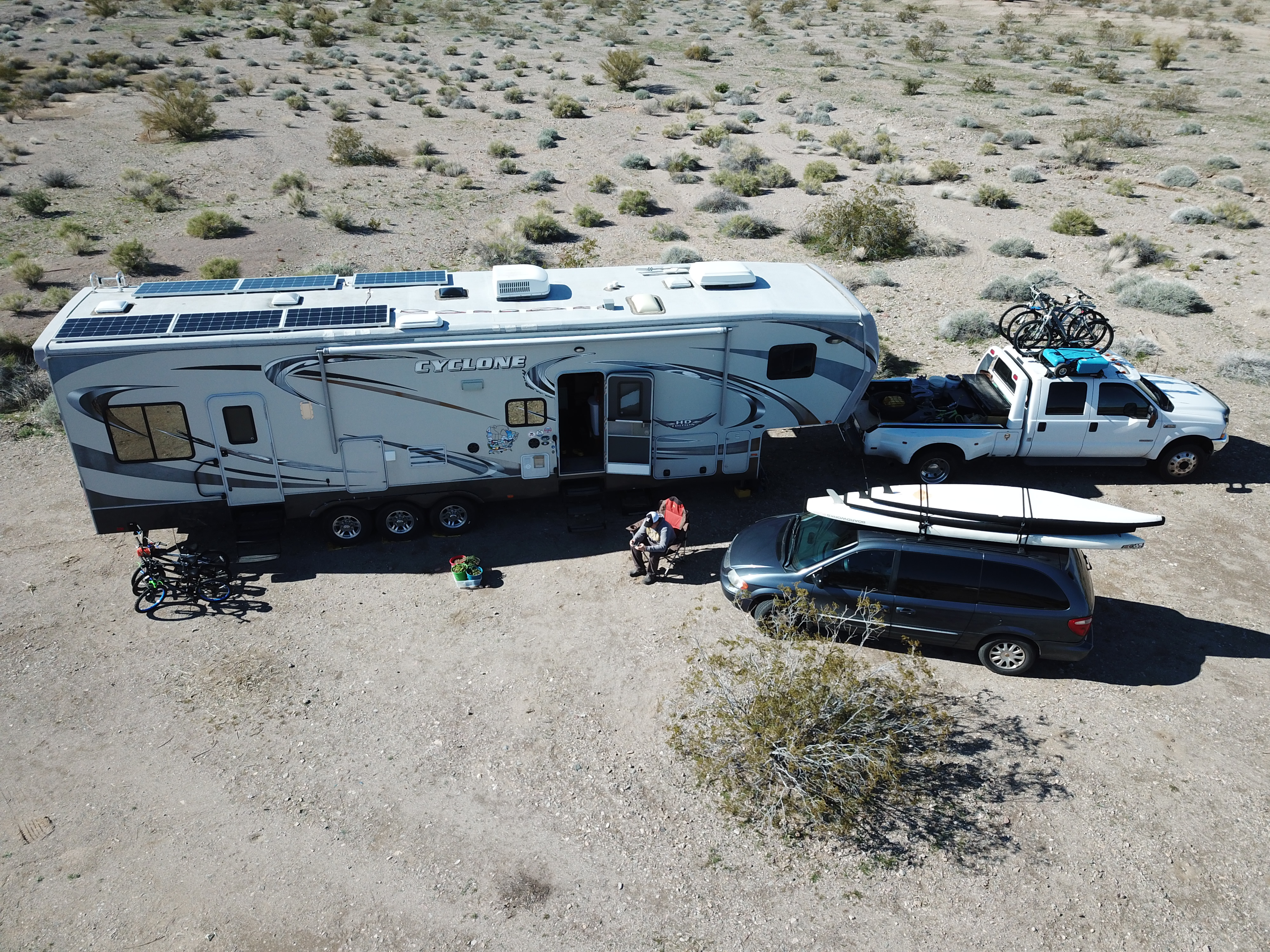We have 7 members in our traveling family so we have more butts than seats for most pick-up trucks(I know there is always an exception), and we chose to go with a Toy Hauler 5th wheel as our home. That means that we have to (or should) tow our home with a dually truck that seats up to 6, therefore needing 1 more seat. So out of all the options out there, we chose to go with our current set up.

When I decided to create this, I really believed that all the data would demonstrate on how much money we were saving by driving 2 vehicles. As crazy as it sounds, I truly believed it to be true. Well I was wrong! Let me explain:
By reading any further, you accept that I am not an expert, nor am I a blogger, but I am telling you how it went down for us!
This is how we roll:
We tow a Toy Hauler 5th wheel with a Ford F550 and it’s followed by a Mini Van Chase Vehicle.
- 2004 Ford F550 Superduty Truck 4×4 Lariat Crew Cab.0 Powerstroke Diesel Engine
- 40 Gallon Fuel Tank
- 26,000 tow capacity
- 8.7 Miles Per Gallon
- Original Purchase Price $16,500
- 2011 Heartland Cyclone 3612 Toy Hauler 5th
- 40’ Long, triple axle
- Approximately 18,000lbs
- Original Purchase Price $35,000
- 2002 Chrysler Town & Country Lxi 7 Passenger Mini van
- 3.8L V6 Engine
- 18 Gallon Fuel Tank
- 19.1 Miles Per Gallon
- Original Purchase Price $4000
One of the best features we like in a vehicle, is paid for. We chose to go older used in order to pay cash, and not go into debt. Something that helps save us some money is that we are from Montana, and as our domicile state, the 5th wheel and the van both have permanent license plates due to age, and although the truck does get renewed yearly, for 2019 it was less than $150. That’s not bad for annual registration on 2 vehicles and a RV.
Everything is insured through Progressive, and all the premiums together for the year are about $2000 on full coverage for everything, plus fulltimers insurance on the 5th wheel. In addition we have roadside assistance through progressive and Verizon.
Both vehicles have had minimal repairs; in 2018 we spent roughly $4400 on vehicle maintenance between both vehicles and another $1500 on parts and service for the Cyclone. That sounds high, but in actuality that includes new tires on all vehicles, including a new spare for the truck (with a roadside bill too). We typically do 2 oil changes a year on each (but do change the filters 4 times a year). The oil is always checked and topped off! Considering the number of miles they have, and are traveling, they both have held together very well for us.
Where am I getting my data?
- All fuel mileage and cost per mile data was collected using a free app on my iPhone called Fuelly, you log your fuel ups, and it gives you spending reports. This is the second app of this kind I have tried of this kind and the free version has done everything I have wanted so far.
- For the 2018 Financials, we use Quicken on our laptop to track expenses, it’s a pain in the butt to keep it entered, but really helps get full analytics for our finances.
Now back to my hypothesis. I believed that because the truck is parked whenever we aren’t towing, the difference in miles would offset the cost of additional vehicle. I was certain we were saving money, but boy was I wrong.
I collected the data from September 1 through the end of the year. Our travels during that time took us from Eastern Oregon (where the 5th wheel was stored during our Alaska adventure) down through Utah to southern California by way of New Mexico and North Texas.
Total spent on fuel was $2440 during that stretch:
- F550 cost an average of .39 cents per mile.
- Driven 4100 miles
- Total $1582 for fuel
- Chase Van cost an average of .16 cents per mile.
- Driven 5500 miles
- Total of $858 spent on fuel
So, if we only had the F550 (and 1 less person).
- It would have driven 5500 miles
- F550 Averages .39 cents per mile
- Would have been a total of $2123
So we would have saved $318 during that time being able to use just the truck. I don’t think we could just multiply that by 4, and have the yearly savings because there are many times we have driven the van a lot exploring and visiting outside of our immediate area.
I will also have to say there are many other benefits to traveling with the chase vehicle.
- We’ve used the van to scout locations before we bring in the rv
- We can use the extra vehicle to get places if the other breaks down, and we can do separate things when necessary, and not rely on 1 vehicle.
- It’s so much easier to park a minivan in a city than a big dually truck.
- I still believe that any wear and tear we can save on the truck, the longer the truck will be reliable.
- Honestly, the convenience the van has provided is well worth the extra $318 we spent.
On a side note, we took a 1989 Winnebago Warrior Class C motorhome “The Summer House” to Alaska, and it averaged .56 cents a miles to drive up and back. That cost is semi misleading, since the cost of fuel up through Canada and in Alaska is higher than the lower 48 so I do believe that we made the right choice taking it to save money on fuel.




